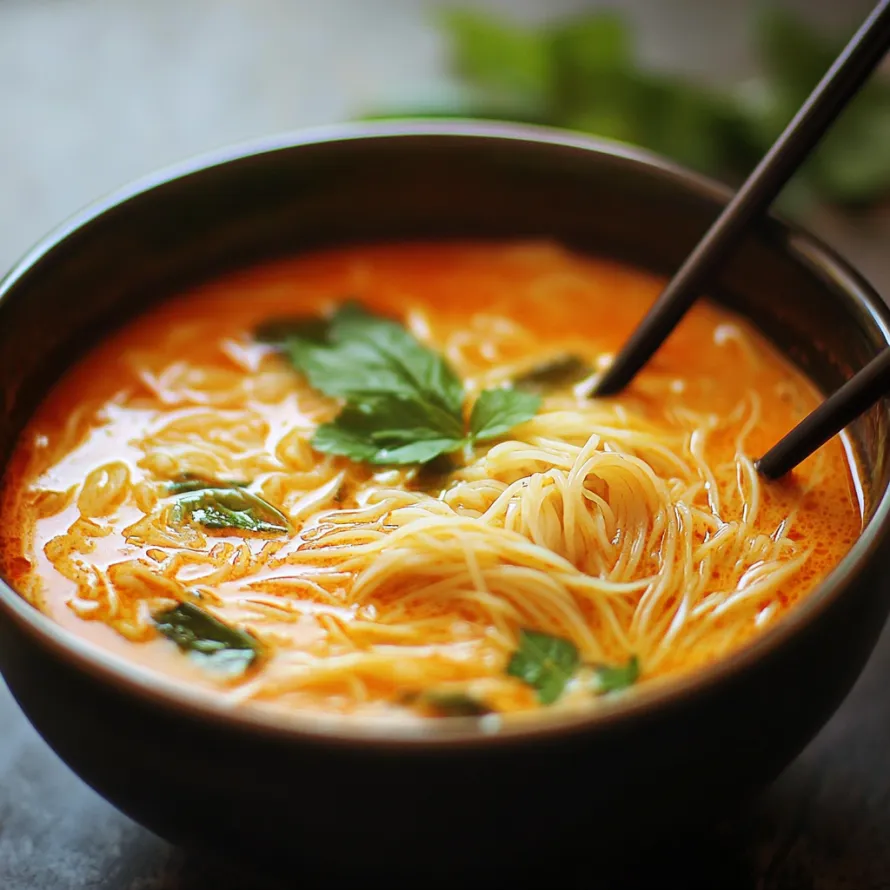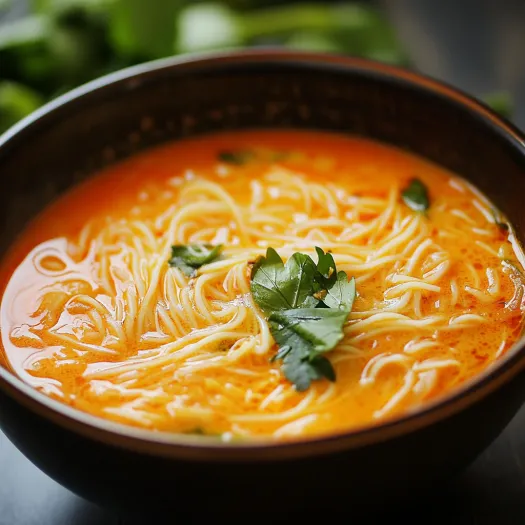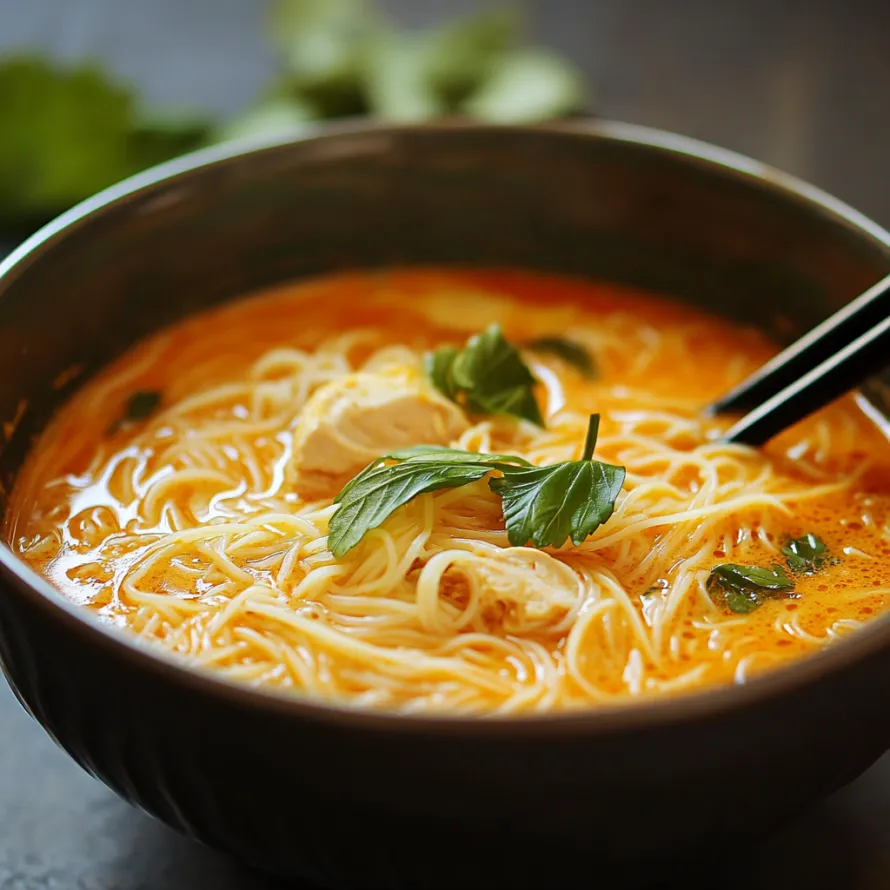 Pin it
Pin it
This aromatic Thai Red Curry Noodle Soup beats takeout hands down with its deep, flavorful broth. Juicy chicken chunks, smooth rice noodles, fresh cilantro, lively basil, and zesty lime juice come together in a comforting bowl that perfectly balances spicy, sweet, tangy, and umami flavors.
I whipped this soup up for my family on a cold night last week. My kitchen smelled amazing as the curry paste sizzled in the oil. Everyone kept popping in asking if dinner was ready yet. When we finally ate, there was total silence at first bite before everyone started raving. By lunchtime next day, not a drop was left.
Key Components
- Coconut Milk: Go for the full-fat kind to get that super smooth, velvety broth
- Red Curry Paste: This brings all the depth and heat to your soup
- Fish Sauce: Gives that wow-factor savory kick that regular salt just can't match
- Rice Noodles: Soak up all that tasty broth while staying nice and chewy
- Chicken: Adds satisfying protein and gets super tender in the coconut bath
- Lime Juice: Wakes up all the flavors and cuts through the coconut's richness
- Fresh Herbs: Cilantro and basil bring freshness and make it look gorgeous
Cooking Steps
- Start With Fragrant Veggies:
- Warm up some oil in a big pot over medium heat. Toss in finely chopped onions and cook till they're see-through. Add crushed garlic and fresh ginger, cooking just till you can smell them but before they turn brown. This makes a flavor foundation for your whole soup.
- Wake Up The Curry Paste:
- Drop the red curry paste into your pot and keep stirring for about two minutes. Don't skip this part. The paste will get super fragrant and a bit darker, showing all those flavors are coming alive in the hot oil.
- Mix Up Your Liquids:
- Pour in your coconut milk and chicken broth, stirring till the curry paste mixes in completely. Let it come to a gentle bubble, but don't let it boil hard or your coconut milk might split. Give these flavors time to get friendly for a few minutes.
- Add Your Meat:
- Drop your chicken pieces into the bubbling broth. Let them cook till they're totally tender and reach 165°F inside. This slow, gentle cooking keeps the meat juicy while it soaks up all those curry flavors.
- Drop In The Noodles:
- Add your rice noodles during the last few minutes of cooking. They'll soften in the hot soup but still keep some bite. Don't cook them too long since they'll keep softening in the hot broth even after you turn off the heat.
- Make It Taste Amazing:
- Right before you serve, stir in some fish sauce, brown sugar, and fresh lime juice. Give it a taste and tweak these till you get that perfect mix of salty, sweet, and tangy. This final touch is what makes homemade Thai food taste authentic.
 Pin it
Pin it
I can't get over how amazing fish sauce is in Southeast Asian cooking. My grandma actually turned me onto it a while back when she saw my Thai food attempts weren't quite hitting the mark. She was spot on. Now I always keep a bottle in my kitchen and splash it into everything from quick stir fries to overnight marinades. The flavor depth it adds is incredible once you get past the initial smell.
Flavor Building Blocks
Red curry paste is what makes this dish special. This flavorful mix combines hot red chilies, garlic, lemongrass, galangal and other spices. You can find Thai Kitchen brand at most stores, and it's pretty good with medium heat. If you want something more authentic, try Mae Ploy which has deeper flavor but contains shrimp paste. Homemade curry paste tastes brighter but you'll need to hunt down special ingredients like galangal root and kaffir lime leaves.
Ways To Switch It Up
Thai food is all about making it your own. Don't have chicken? Throw in some peeled shrimp or diced firm tofu for a meat-free option. You can toss in thinly sliced mushrooms, bright bell peppers, baby corn, or crunchy snow peas too. Not feeling rice noodles? Try bouncy udon or thin vermicelli instead. Want a different flavor altogether? Green curry paste works great too and brings more herby notes compared to the red stuff.
How To Store Leftovers
If you've got soup left over, keep the parts separate for best results. Put the broth in a sealed container in the fridge for up to three days. Store your cooked noodles in their own container with a tiny bit of oil mixed in so they don't stick together. When you're ready to eat again, warm the broth slowly on the stove until it bubbles, then add the noodles just long enough to heat them up. Don't try freezing this soup though. The coconut milk gets weird when thawed and the noodles turn to mush.
 Pin it
Pin it
This Thai Red Curry Noodle Soup has become my secret weapon when I want folks to think I spent all day cooking. The incredible flavor seems way more complex than the actual effort involved, and it looks stunning in the bowl. I find myself wanting these particular spicy-creamy-tangy flavors more than almost anything else I cook. There's something about how the coconut tames the heat while the lime cuts the richness that makes every spoonful just perfect.
Frequently Asked Questions
- → Can I make this without chicken?
- Absolutely! Swap chicken for firm tofu or more veggies like mushrooms and carrots. Use vegetable broth instead of chicken broth, and switch fish sauce for soy sauce or tamari.
- → Is it really spicy?
- That depends on your red curry paste. Most store-bought ones are moderately hot. Use less paste and add more coconut milk to tone it down, or throw in Thai chilies for more kick.
- → How far ahead can I prep this dish?
- You can make the broth and chicken a day early, then refrigerate it. When you’re ready, warm it up, toss in the noodles to soften, and finish with herbs and lime.
- → What’s a good swap for fish sauce?
- Soy sauce with a splash of fresh lime juice works well. For a vegan option, look for seaweed-based fish sauce alternatives.
- → How long will leftovers last?
- Keep leftovers in the fridge for 2-3 days. It’s a good idea to store the noodles separately so they don’t soak up too much broth and get mushy.
- → Can you freeze this dish?
- You can freeze the broth and chicken (without noodles or herbs) for up to 3 months. When it’s time to eat, reheat it, cook fresh noodles, and garnish with herbs.
